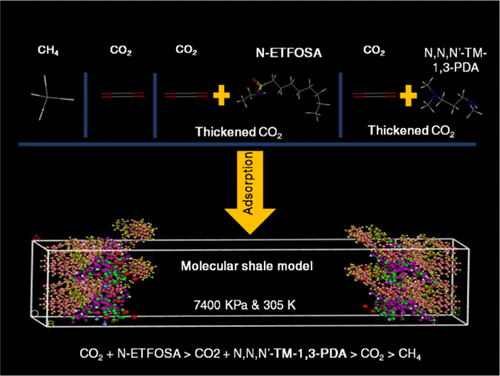当前位置:
X-MOL 学术
›
Energy Fuels
›
论文详情
Our official English website, www.x-mol.net, welcomes your
feedback! (Note: you will need to create a separate account there.)
Effects of a Viscoelastic Surfactant on Supercritical Carbon Dioxide Thickening for Gas Shale Fracturing
Energy & Fuels ( IF 5.2 ) Pub Date : 2021-09-17 , DOI: 10.1021/acs.energyfuels.1c01215 Muhammed Rashik Mojid 1 , Berihun Mamo Negash 1, 2 , Kawthar Adewumi Babatunde 1 , Tigabwa Y. Ahmed 2 , Shiferaw Regassa Jufar 1, 2
Energy & Fuels ( IF 5.2 ) Pub Date : 2021-09-17 , DOI: 10.1021/acs.energyfuels.1c01215 Muhammed Rashik Mojid 1 , Berihun Mamo Negash 1, 2 , Kawthar Adewumi Babatunde 1 , Tigabwa Y. Ahmed 2 , Shiferaw Regassa Jufar 1, 2
Affiliation

|
Among waterless fracturing fluids, supercritical carbon dioxide (Sc-CO2) has been increasingly emphasized in recent years for hydrocarbon recovery from shale. Sc-CO2 is the most feasible choice to be an alternative to conventional hydraulic fracturing with the ability to alleviate global warming. However, Sc-CO2 fracturing is encumbered with problems such as poor proppant-carrying capacity, easy sand plugging, large displacement, and high frictional resistance. The main aim of this study is to investigate the thickening of Sc-CO2 by adding viscoelastic surfactants (VESs) for increasing the proppant-carrying capacity and to understand the preferential adsorption of this thickened Sc-CO2 over methane on a heterogeneous molecular shale model. From the literature, it was found that a fluorinated polymer provides good CO2 solubility and also thickens CO2. As a result, fluorinated VES, N-ethyl perfluorooctyl sulfonamide (N-ETFOSA), and nonfluorinated VES, N,N,N′-trimethyl-1,3-propanediamine (N,N,N′-TM-1,3-PDA), were used in this study for comparison. The molecular simulation of thickening Sc-CO2 employing N-ETFOSA and N,N,N′-TM-1,3-PDA was carried out at a temperature and pressure ranging from 298 to 305 K and 100 to 7400 kPa, respectively. Although N,N,N′-TM-1,3-PDA shows better solubility in Sc-CO2 than N-ETFOSA, both of them cause an increase in the viscosity of Sc-CO2 by 36 and 156 times, respectively, than its actual viscosity. Adsorption simulations of CO2-thickened Sc-CO2 and methane (CH4) were performed on a heterogeneous molecular shale model. With increasing pressure at a constant temperature, N-ETFOSA-thickened Sc-CO2 showed better adsorption capacity on the molecular shale model than others. Accordingly, at higher pressure, N-ETFOSA-thickened Sc-CO2 shows better selectivity over methane. The results of viscosity and adsorption simulations have been validated by literature experiments. Nonetheless, these outstanding simulation findings need more experimental backup to pave their implementation on real field scenarios. Thus, this study helps establish a theoretical ground for the optimization of shale gas extraction from shale plays and makes it viable storage for CO2 sequestration.
中文翻译:

粘弹性表面活性剂对页岩气压裂超临界二氧化碳增稠的影响
在无水压裂液中,超临界二氧化碳(Sc-CO 2)近年来越来越受到页岩油气回收的重视。Sc-CO 2是替代传统水力压裂的最可行选择,具有缓解全球变暖的能力。但Sc-CO 2压裂存在支撑剂承载能力差、易堵砂、排量大、摩擦阻力大等问题。本研究的主要目的是通过添加粘弹性表面活性剂 (VES)来研究 Sc-CO 2的增稠,以提高支撑剂承载能力,并了解这种增稠的 Sc-CO 2的优先吸附非均质分子页岩模型上的甲烷。从文献中发现,氟化聚合物提供良好的CO 2溶解度并且还增稠CO 2。其结果,氟化VES,Ñ -乙基全氟辛基磺酰胺(Ñ -ETFOSA),和非氟化VES,Ñ,Ñ,Ñ ' -三甲基-1,3-丙二胺(Ñ,Ñ,Ñ '-TM-1,3- PDA),用于本研究进行比较。使用N - ETFOSA和N , N , N增稠Sc-CO 2的分子模拟'-TM-1,3-PDA 分别在 298 至 305 K 和 100 至 7400 kPa 的温度和压力下进行。尽管N , N , N '-TM-1,3-PDA 在 Sc-CO 2 中的溶解度比N -ETFOSA 更好,但它们都使 Sc-CO 2的粘度分别增加了 36 倍和 156 倍,比它的实际粘度。CO 2增稠的Sc-CO 2和甲烷(CH 4)的吸附模拟在非均质分子页岩模型上进行。在恒定温度下,随着压力的增加,N -ETFOSA 增稠的 Sc-CO 2在分子页岩模型上显示出比其他模型更好的吸附能力。因此,在更高的压力下,N -ETFOSA 增稠的 Sc-CO 2显示出比甲烷更好的选择性。粘度和吸附模拟的结果已通过文献实验得到验证。尽管如此,这些出色的模拟结果需要更多的实验支持来为它们在实际现场场景中的实施铺平道路。因此,本研究有助于为优化从页岩区开采页岩气并使其成为可行的 CO 2封存封存建立理论基础。
更新日期:2021-10-07
中文翻译:

粘弹性表面活性剂对页岩气压裂超临界二氧化碳增稠的影响
在无水压裂液中,超临界二氧化碳(Sc-CO 2)近年来越来越受到页岩油气回收的重视。Sc-CO 2是替代传统水力压裂的最可行选择,具有缓解全球变暖的能力。但Sc-CO 2压裂存在支撑剂承载能力差、易堵砂、排量大、摩擦阻力大等问题。本研究的主要目的是通过添加粘弹性表面活性剂 (VES)来研究 Sc-CO 2的增稠,以提高支撑剂承载能力,并了解这种增稠的 Sc-CO 2的优先吸附非均质分子页岩模型上的甲烷。从文献中发现,氟化聚合物提供良好的CO 2溶解度并且还增稠CO 2。其结果,氟化VES,Ñ -乙基全氟辛基磺酰胺(Ñ -ETFOSA),和非氟化VES,Ñ,Ñ,Ñ ' -三甲基-1,3-丙二胺(Ñ,Ñ,Ñ '-TM-1,3- PDA),用于本研究进行比较。使用N - ETFOSA和N , N , N增稠Sc-CO 2的分子模拟'-TM-1,3-PDA 分别在 298 至 305 K 和 100 至 7400 kPa 的温度和压力下进行。尽管N , N , N '-TM-1,3-PDA 在 Sc-CO 2 中的溶解度比N -ETFOSA 更好,但它们都使 Sc-CO 2的粘度分别增加了 36 倍和 156 倍,比它的实际粘度。CO 2增稠的Sc-CO 2和甲烷(CH 4)的吸附模拟在非均质分子页岩模型上进行。在恒定温度下,随着压力的增加,N -ETFOSA 增稠的 Sc-CO 2在分子页岩模型上显示出比其他模型更好的吸附能力。因此,在更高的压力下,N -ETFOSA 增稠的 Sc-CO 2显示出比甲烷更好的选择性。粘度和吸附模拟的结果已通过文献实验得到验证。尽管如此,这些出色的模拟结果需要更多的实验支持来为它们在实际现场场景中的实施铺平道路。因此,本研究有助于为优化从页岩区开采页岩气并使其成为可行的 CO 2封存封存建立理论基础。











































 京公网安备 11010802027423号
京公网安备 11010802027423号